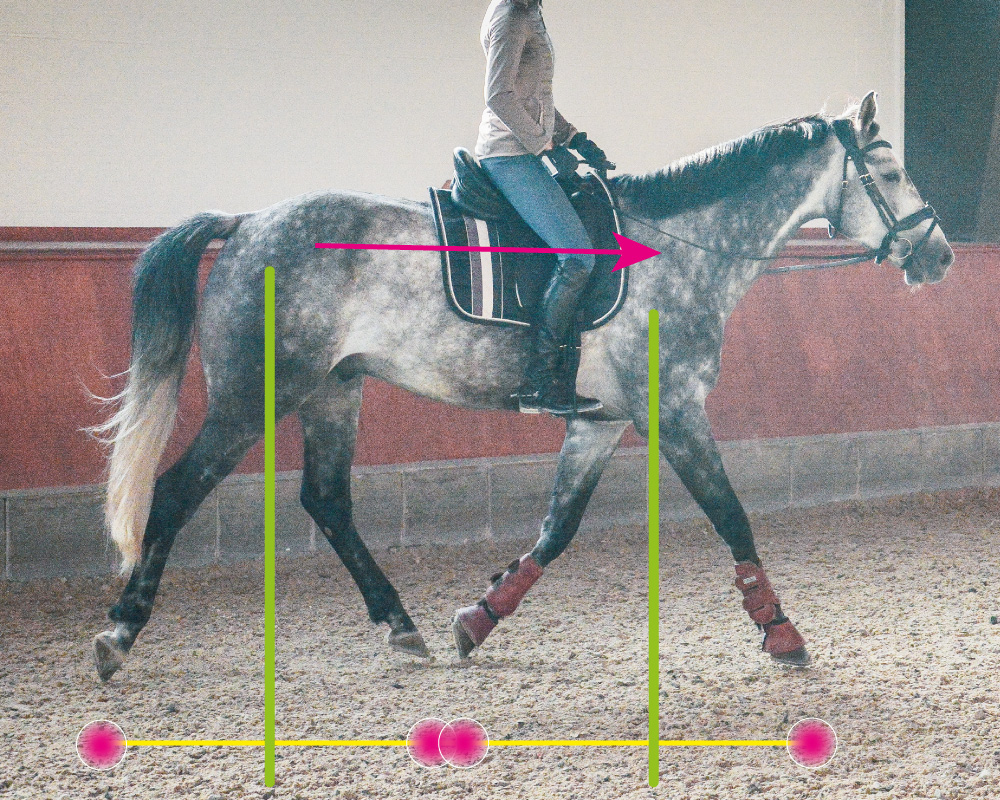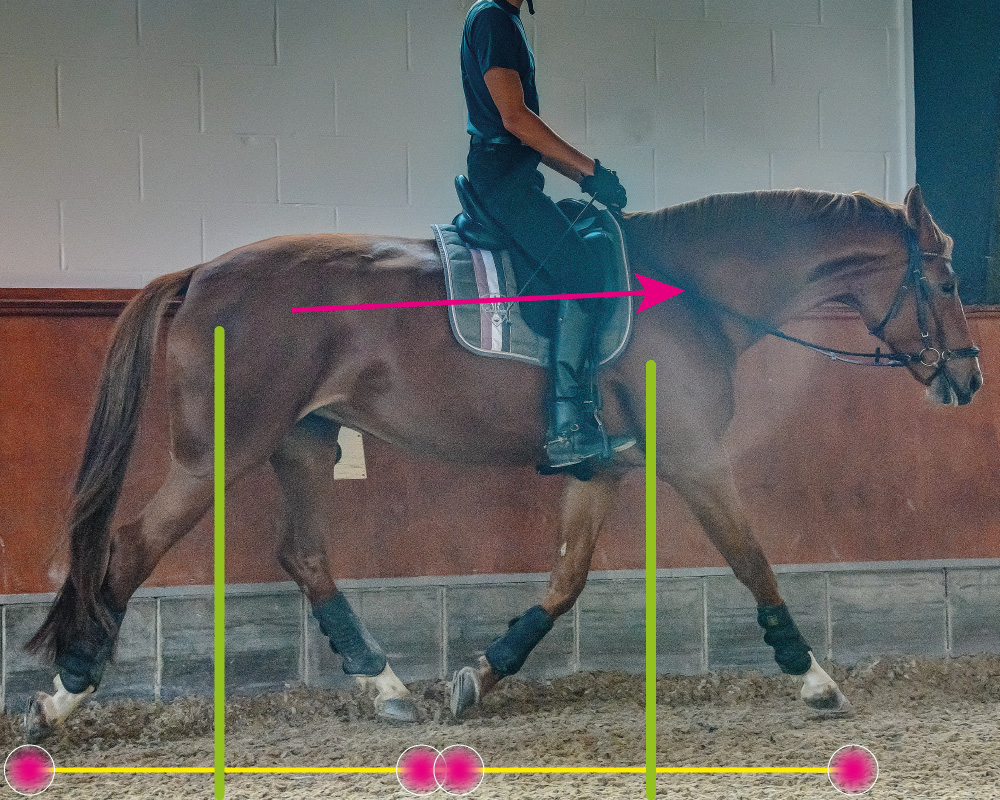What does it mean if you say a horse carries itself?
There is probably no rider who does not throw around the words a horse does “carry itself”, “balance itself” or keeps “in a natural upright position”.
Nevertheless, most riders seem to consistently forget the most important part of these terms. Itself
I think that this itself can only result from a correct and by the rider uninfluenced training in the first three points of the training scale.
We don’t have to teach a horse “its” rhythm or keep it in “its” rhythm. We just have to be able to feel the real rhythm of the horse’s movement and not disturb it. If the horse doesn’t find his rhythm, we won’t change the fact with any riding strategy in the world.
But we have to search for the causes.
It’s probably a matter of balance of balance. If the horse has osteopathic lesions, or in normal words: blockades, there will always be a problem in balance and the horse won’t find its rhythm. In this case we should treat these blockages and not stubbornly try to force the horse into a rhythm with equestrian means. We cannot force it.
The idea of influencing the rhythm by “riding backwards” fast horses (a horrible expression) or making slow horses fast is nice. But we should remember that no horse dawdles or runs away because it has this idea. It’s because there are problems with the balance, i.e. blockades and pain with the corresponding movement.
Thus we should never try to combine rhythm and impulsion.
Impulsion and rhythm have nothing to do with each other. Just like an A-dressage has nothing to do with collection.
The rhythm takes just the amount of time as the horse needs to perform a room encompassing movement, i.e. up to the limit of of the bending and stretching in a joint. If we start to force the rhythm, the horse will prematurely stop a movement in order to keep the rhythm forced upon it. It will be out of balance, does not carry itself and does not look for contact in a stretching posture.

A horse without stretching in the upper neck and out of balance. The leg movement forward is clearly limited in comparison to the one to the back, especially in the frontleg. The horse falls down in the muscles that carry the torso, it falls on the forehand. It is not able to keep a circle line and when the rider shortens the reins the horse will walk with the nose behind the vertical.
So rhythm, suppleness and contact are training points that can only be achieved by the horse itself. The rider has nothing to do but keeping his own balance and not disturbing the horse.
Also we always speak of equestrian aids.
But I wouldn’t call it aid if I kept a horse in “its” rhythm by constantly pushing it. Or it is clamped between both thighs so that it is in “balance”. That would then be more of a coercive measure.
Yesterday I was allowed to watch the live training of Mrs. Uphoff-Selke on the Equitana.
I am not going to make a scene against Mrs Uphoff-Selke.
She is one of our best riders and a very sensitive trainer. I fact that she has decided to turn her back on a dressage sport that has lost sight of the horse’s well-being and treats the horse like a lifeless and unfeeling piece of sports equipment highly admirable. There is no honor in people who know no measure and no compassion, that have horses only to earn money and get prestige. For me, real riding stops where greed and narcissism begin.
And if the well-founded criticism of the unscrupulous and cruel “riding” of some nations and riders brings the suspension of the FN and a prosecution by lawyers to a highly decorated and biomechanically very experienced FEI judge, then the FN and its dressage sport have degraded in my eyes.
Nevertheless, I would like to make a few criticisms about the live training.
The first pair was an example of how perfect riding on a gently trained horse can look like. Relaxed, trusting, in perfect support and harmony.

horse that is free and self-carrying. It searches with stretched upper neck line and forward for contact to the riders hand. The spatial grip in extension and flexion are of equal length, which enables the horse to find its balance.
Unfortunately, not so the following couples.
Each of these horses ran clearly behind the vertical (problem with contact) and had one or the other kind of problems with rhythm and suppleness. Mrs. Uphoff-Selke called this a snapshot and one should look at the whole horse.
With the latter I go d’accord, with the term snapshot not. Maybe we should finally start to consider a head worn behind the vertical as a basic problem in the first three training points and not try to ignore this problem with lection riding.
The second pair showed a clearly overhasty rhythm resulting in a physical and mental tension of the horse. The horse paddled nicely with his legs, but hardly showed any movement in the spine and let his back sag. It always seemed as if it would fall apart in the next moment and is stiff in its turns.
The third couple had far-reaching problems due to the physiology of the horse. Although at first sight it seemed tactful, it showed shortenings in the demonstration phase of the outer hind limbs because it lacked balance in the turns.
This horse is extremely agile and flexible with large movements. One should think it was beautiful. Nevertheless, these horses are extremely difficult to train. If I now say that such horses have problems with letting go, you will scream first of all.
But what does suppleness mean?
Not that a horse is running slabbery. Suppleness presupposes a certain basic tone of the musculature. The horse must be able to stabilise itself so that it can also balance itself. This is the problem of this horse.
Most riders tend to want to stabilize such horses from the outside. With the reins and the thighs. Framing is what we call this in riding. But no frame, no matter how well it is meant, is a substitute for the horse’s own balance. Such animals need a lot of time to find a stable balance. And we have to give them that. Without reins and without thighs.
In addition, the rider insecures the horse with the fact that she often sits clearly behind the vertical and thus further restricts the horse’s ability to carry herself.
The fourth pair also showed a hasty rhythm and the resulting problems in suppleness and ´contact. This was especially evident in the piruette exercises. There the horse visibly slowed down its rhythm. A sure sign that it would need a slower rhythm to be able to carry “itself” and to take up weight.
All three horses are actually not far enough in their training to be ridden into the training points impulsion, straightening and collection. You can’t correct those horses for real, if you won’t go back to the training point rhythm.
Rhythm without the influence of the rider. While lounging. And with a lot of patience. Corrections by lection riding is not a satisfactory solution. You will always ride these horses with massive influence and from behind to the vertical. The goal, however, should be a horse that actively seeks a forward contact.